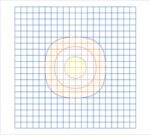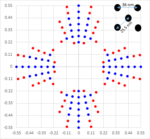In the assessment of wafer lithography processes, normalized image log-slope (NILS) gives the % change in width for a given % change in dose [1,2]. A nominal NILS value of 2 indicates 10% change in linewidth for 10% change in dose; the % change in linewidth is inversely proportional to the NILS. In a previous article [2], it was shown… Read More
Assessing EUV Wafer Output: 2019-2022
At the 2023 SPIE Advanced Lithography and Patterning conference, ASML presented an update on its EUV lithography systems in the field [1]. The EUV wafer exposure output was presented and is shown below in table form:
From this information, we can attempt to extract and assess the EUV wafer output per quarter. First, since there … Read More
Application-Specific Lithography: 28 nm Pitch Two-Dimensional Routing
Current 1a-DRAM and 5/4nm foundry nodes have minimum pitches in the 28 nm pitch range. The actual 28 nm pitch patterns are one-dimensional active area fins (for both DRAM and foundry) as well as one-dimensional lower metal lines (in the case of foundry). One can imagine that, for a two-dimensional routing pattern, both horizontal… Read More
A Primer on EUV Lithography
Extreme ultraviolet (EUV) lithography systems are the most advanced lithography systems in use today. This article is a basic primer on this important yet complex technology.
The Goal: A Smaller Wavelength
The introduction of 13.5 nm wavelength continues a trend the semiconductor industry had been following a wavelength reduction… Read More
SPIE 2023 – imec Preparing for High-NA EUV
The SPIE Advanced Lithography Conference was held in February. I recently had the opportunity to interview Steven Scheer, vice president of advanced patterning process and materials at imec and review selected papers that imec presented.
I asked Steve what the overarching message was at SPIE this year, he said readiness for … Read More
Curvilinear Mask Patterning for Maximizing Lithography Capability
Masks have always been an essential part of the lithography process in the semiconductor industry. With the smallest printed features already being subwavelength for both DUV and EUV cases at the bleeding edge, mask patterns play a more crucial role than ever. Moreover, in the case of EUV lithography, throughput is a concern, … Read More
Reality Checks for High-NA EUV for 1.x nm Nodes
The “1.xnm” node on most roadmaps to indicate a 16-18 nm metal line pitch [1]. The center-to-center spacing may be expected to be as low as 22-26 nm (sqrt(2) times line pitch). The EXE series of EUV (13.5 nm wavelength) lithography systems from ASML feature a 0.55 “High” NA (numerical aperture), targeted… Read More
LAM Not Yet at Bottom Memory Worsening Down 50%
-Lam reported in line results on reduced expectations
-Guidance disappoints as memory decline continues
-Memory capex down 50% but still sees “further declines”
-Lam ties future to EUV maybe not good idea after ASML report
Lam comes in above grossly already reduced expectations
and misses on guidance
We always … Read More
ASML Wavering- Supports our Concern of Second Leg Down for Semis- False Bottom
-ASML weakness is evidence of deeper chip down cycle
-When ASML sneezes other chip equip makers catch a cold
-Will backlog last long enough? Will EUV demand hold up?
-“Unthinkable” event, litho cancelations, could shock industry
ASML has in line quarter but alarm bells ring on wavering outlook
ASML reported Euro6.7B… Read More
Can Attenuated Phase-Shift Masks Work For EUV?
Normalized image log-slope (NILS) is probably the single most essential metric for describing lithographic image quality. It is defined as the slope of the log of intensity, multiplied by the linewidth [1], NILS = d(log I)/dx * w = w/I dI/dx. Essentially, it gives the % change in width for a given % change in dose. This is particularly… Read More









Quantum Computing Technologies and Challenges